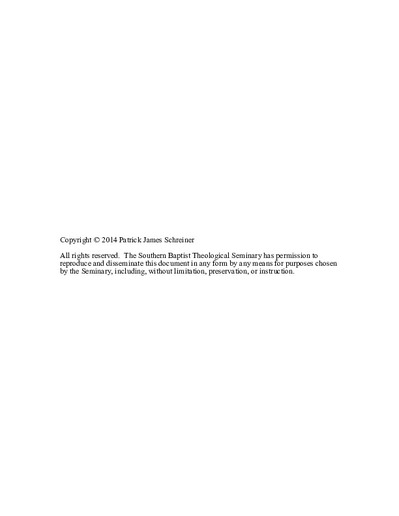People and Place: A Spatial Analysis of the Kingdom in Matthew
Subject
Jesus Christ--KingdomBible. Matthew--Criticism, interpretation, etc.
Place (Philosophy) in the Bible
Space--Religious aspects--Christianity
Abstract
This dissertation seeks to answer the following question: how do recent spatial theories help one interpret Jesus' bringing of the kingdom in Matthew? The thesis argued that Jesus comes to reorder the space of the earth in Matthew uniting the two realms of heaven and earth through his body and through the body of his community.
Chapter 1 demonstrates that although a resurgence in examining the land and spatial dimensions in the Scripture are underway, scholars in biblical studies still view space too narrowly. The conversation surrounding the spatial kingdom has been stunted in part due to the influence of Gustaf Dalman and George Eldon Ladd's definition of the kingdom.
Chapter 2 examines two of Matthew's distinct themes, his focus on the spatial nature of the kingdom and the presence of Jesus. References to οὐρανός and γη and the Immanuel theme both provide warrant for examining the spatial kingdom in Matthew's narrative.
Chapter 3 overviews recent advances in spatial theory arguing for a view called critical spatiality. Critical spatiality provides a way to understand space as a social product. Three categories for spatial understanding expand the conception of space. Space is physical, ideological, and imaginative. A trialectic of space, rather than a dialectic, begins to open up new ways of thinking of space.
Chapters 4 examines one of the deeds of Jesus from a spatial perspective. When Jesus contests Beelzebul in Matthew 12, he challenges the "lord of the earth." By entering Satan's house, conquering him, and bestowing life to the exorcised person he reorders the space of the earth.
Chapter 5 argues that the Spirit, in the Beelzebul controversy and Matthew more generally, inaugurates the new exodus/creation. Exorcisms are at least partly about power over place and the exorcism is one way in which the spatial kingdom is becoming in Jesus' ministry.
Chapter 6 broadens the scope and moves to an overview of the first three discourses in Matthew. Jesus' words create worlds in the Sermon on the Mount where he calls his disciples to be salt and light on the earth. In the commissioning of the disciples, Jesus tells his disciples to go out bringing peace to places by healing the sick, raising the dead, and casting out demons. Jesus then explains in the kingdom parables that the space of the earth is the theater upon which the kingdom is enacted. The kingdom is here but hidden in plain sight upon the earth.
Chapter 7 covers the last two discourses of Matthew. Jesus forms a meek community in the community discourse, creating a place in contrast to the communities of the earth. In the last discourse, Jesus contests the most important sacred space in the ancient world, the temple, and replaces it with his body.
Chapter 8 analyzes two final texts that provide an inclusio to chapter 2. Both the spatial kingdom and the Immanuel theme are spoken of in Matthew 19:28 and 18:20 respectively. In Matthew 19:28 Jesus speaks of the new world and the new family. Then Jesus promises his presence to his church in Matthew 18:20, so that they can continue the spatial work.
Chapter 9 argues Jesus' body and presence are the key to uniting the spatial and presence themes in Matthew. The body of Jesus is a microcosm of heaven and earth, and the kingdom is a thirdspace.

